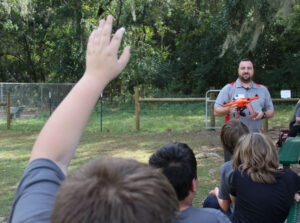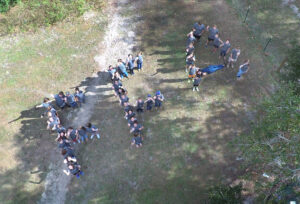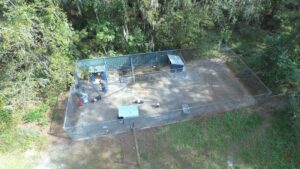Gleim Aviation spoke to the High Springs (Florida) Community School FFA program in November to discuss how drones are being used in agriculture. The visit marked a chance for students to take part in the ongoing discussion about how this emerging technology can be used to assist in crop and cattle farming. Paul Duty, CFI, commercial pilot, remote pilot, and Gleim Aviation Instructor, used the opportunity to explain the benefits that drones can provide to agricultural businesses and communities and some of the science behind them.
Duty asked a series of questions to the students and followed up on their responses by going into the science of aviation and its relevance to the future of agriculture. Duty began by asking, “How do planes fly?”
A student eagerly raised his hand and answered, “Lift, drag, throttle, and thrust.” Duty encouraged their answers and guided the students to the four forces of flight- “Close. It is actually lift, drag, thrust, and gravity.”
 When asked if any of them had ever heard of Bernoulli, one student asked, “the Bernoulli Theory?”
When asked if any of them had ever heard of Bernoulli, one student asked, “the Bernoulli Theory?”
“Yes,” Duty said. He went on to explain Bernoulli’s Principle to the students and conduct a simple experiment using a piece of notebook paper to demonstrate lift. At that moment, a plane was heard flying overhead, a reminder about just how relevant aviation is.
Duty covered the science of flight, touching on topics such as airfoils, air pressure, and control surfaces. He spent time focusing on aviation terminology, and Duty discussed UAVs, UASs, and sUASs and how their use can fall into two categories: hobby and commercial. Note: “UA” means unmanned aerial, “V” is vehicle, “S” is system, “s” is small.
The topic of drones led to Duty asking an important question, “What are drones used for?”
One student said, “Amazon dropping off packages,” and another said, “Spying.” Then Duty discussed the solutions drones could offer for real estate agents, construction companies, and many more professions. In agriculture alone, Duty explained how drones assisted with crop management, drought monitoring, vegetation inspection, pest control monitoring, plant examination, and precision agriculture.
Duty compared a crop duster airplane spreading chemicals on an entire field and to how a drone can pinpoint specific areas for crop management. “In addition, using drones for crops can eliminate many of the risks that crop duster pilots often face during low altitude flights, such as collision hazards with trees and telephone wires,” Duty noted. When asked about cattle management, a student said you can use a drone to locate cattle, and Duty added more detail about using drones to spot pests and chase them away.
A student raised his hand. “How much does a drone weigh?” Duty took this opportunity to explain payloads and how much payload capacity drones have based on what they are made of and what they are carrying.
The requirements for becoming a remote pilot start with turning 16 years old. “In just a couple of years, most of you could fly drones as a job. But first you have to learn about aviation, regulations, and airspace.” Duty explained that students can start learning more about drones or become a Remote Pilot using online training.

“When you are close to airports or cities, the airspace changes and there are certain places you can and cannot fly,” Duty said. Students also learned about flight system operations and emergency procedures, such as lost link connections and a fly away. Finally, students were introduced to weather and the effects of air density on aircraft performance.
As he began to conclude the Q&A portion, Duty explained that operating a drone for science or business comes with responsibilities, and that those responsibilities can require a crew to assist the pilot. He went on to discuss the role of a visual observer on a drone operation crew. “Their job is to help spot the drone and identify hazards when the pilot’s attention is on the controls,” and he recapped the requirements to become a remote pilot: applicants must be 16, learn the aeronautical knowledge, and pass a test made up of 60 multiple-choice questions. “Once you pass that, there is an online application to fill out and you can become an FAA-certificated remote pilot, giving you all the privileges of flying a drone for hire.”
 After discussing several safety considerations, Duty launched a drone up in the air. Once it reached about 30 feet high, Duty completed some maneuvers, took pictures of the new pig enclosure and goat pens to share with the program’s donors, and left the class with a treat. The students lined up and spelled out the letters F-F-A. The Science and Agriculture teacher, Jessica Butts, ran over to the letter “A” and laid down on the ground to become the horizontal line that completes the shape.
After discussing several safety considerations, Duty launched a drone up in the air. Once it reached about 30 feet high, Duty completed some maneuvers, took pictures of the new pig enclosure and goat pens to share with the program’s donors, and left the class with a treat. The students lined up and spelled out the letters F-F-A. The Science and Agriculture teacher, Jessica Butts, ran over to the letter “A” and laid down on the ground to become the horizontal line that completes the shape.
Butts said the demonstration provided the connection between drones and agriculture for her students. “The students really enjoyed watching. Some of them had different experiences with drones previously, but a lot of them hadn’t thought about using technology in agriculture, so I think it opened the doors for them to experience that.”
About Gleim Aviation
Since 1980, Gleim Aviation’s team of pilots, instructors, writers, designers, and programmers has helped aviators pass millions of FAA knowledge and practical tests using the unique Gleim Knowledge Transfer System. Gleim is an environmentally-friendly company headquartered in Gainesville, FL.

